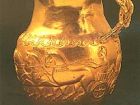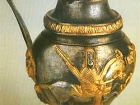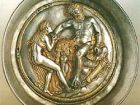THE ROGOZEN TREASURE - THE UNTOLD RICHES OF A THRACIAN NOBLE
THE ROGOZEN TREASURE
THE UNTOLD RICHES OF A THRACIAN NOBLE
THE UNTOLD RICHES OF A THRACIAN NOBLE
The story of the third treasure is most unusual.
In the autumn of 1985 a tractor-driver of the village of Rogozen, Vratza region, was digging a canal in his vegetable garden in the yard of his house, almost in the center of the village.
Quite unexpectedly, a gold vessel popped up on the surface. The surprised man and his wife rummaged through the earth and found 65 such vessels. They took them home, taking them to be church attributes. They didn't forget to inform the mayor of the village and he informed the Museum of History in Vratza.
Archeologists came and started excavations. Unexpectedly again they found a hole full of about 100 vessels. Thus the overall number of find amounted to 165, something unobserved to this day.
Naturally the question arose - what period did they belong to, who was their owner, what was their function, why were they buried into the ground, and what was their historical value?
It turned out that it was a silver treasure weighing 20 kg. Judging from their appearance the vessels were vials (the Greek name of shallower were produced by using a matrix (mould), with additional engravings or application of gold leaves on some of them.
It turned out that it was a silver treasure weighing 20 kg. Judging from their appearance the vessels were vials (the Greek name of shallower were produced by using a matrix (mould), with additional engravings or application of gold leaves on some of them.
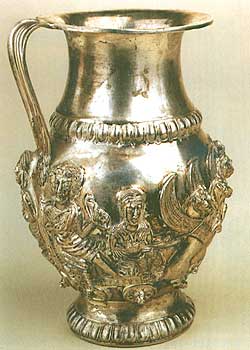 It became clear that the find could be attributed to the ancient Thracian period (end of 5th and middle of 4th c. BC or about 2500 years ago). It was also clear that it belonged to some local Thracian noble. This was the period in which the Thracians managed to build their own state uniting the numerous Thracian tribes and bore the name of the State of the Odrizi after the name of the most powerful among them -the Odrizi.
It became clear that the find could be attributed to the ancient Thracian period (end of 5th and middle of 4th c. BC or about 2500 years ago). It was also clear that it belonged to some local Thracian noble. This was the period in which the Thracians managed to build their own state uniting the numerous Thracian tribes and bore the name of the State of the Odrizi after the name of the most powerful among them -the Odrizi.Scholars decided that the vessels were parts of different sets. They had been collected for a long time and represented a family treasure, handed down from generation to generation. They must have been buried into the ground at the time of disaster or danger hoping that after its end their owners would collect them again. No doubt such a danger appeared during the time of the marches of the Macedonian kings Philip II and Alexander III the Great (382-323 BC).
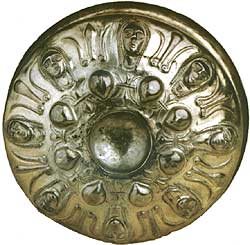
Naturally the great historical value of these vessels is not in the precious metals but in their unique decorations. In them we can notice various motifs. There is a range of geometric figures: elements of plants (tree branches, rose twigs, lotus blossoms; animal figures (winged lions - griffins, winged Pegasuses, winged goats) and realistic figures (dogs, panthers, and birds). Among the mythological symbols most interesting are religious and ritual scenes, representing the beliefs of the ancient people. Such a scene is, for example, the meeting of the ancient hero Heracles and Avge - the priestess of the goddess Pallas Athena. There was also the battle of Heracles with the mythical ama-zons (warlike and insidious creatures of the unreal mysterious world).
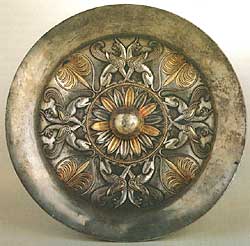
Most important for us are the images of the Thracian Great Goddess, worshipped even by the ancient Greeks under the name of Bendida. She is represented as a mighty rider of a lion or driving a chariot with four horses.

On several of the vessels there are inscriptions containing Thracian personal names (Cotis, Satok, Kerseblept), as well as the names of Thracian settlements unknown to us (Saidava, Beo, Argiske). These inscriptions give clear indication of the creators of the vessels and the settlements where there were made. For these settlements is Thracian without any doubt.
This is the reason why the Rogozen Treasure is of exceptional importance as a monument of the history and the culture of the ancient Thracians.
Their culture combines original artistic tradition and motifs, borrowed from ancient Greek mythology.
Their artistic and technical knowledge has left a lasting and deep trace in the applied crafts and the artistic images, unparalleled in their exquisiteness.
This treasure still remains a unique monument of ancient art in our lands.





